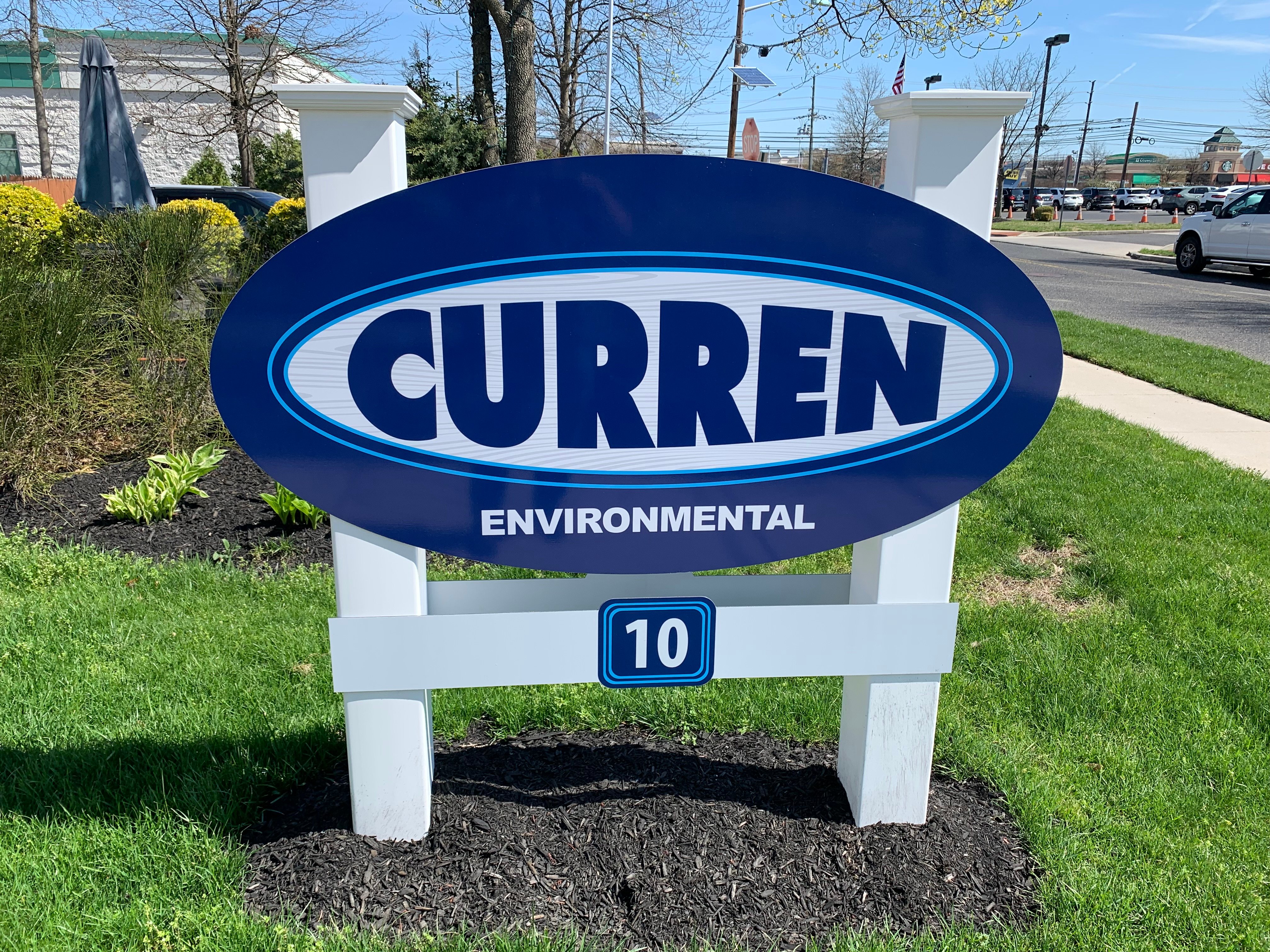Lead Paint Frequently Asked Questions
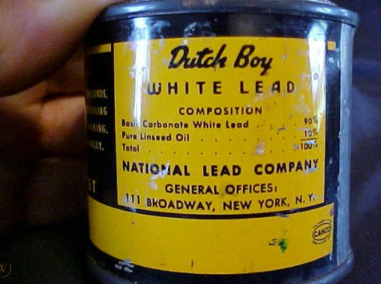
What is lead paint?
Lead was a wonder metal, lead was expensive and when it was added to paint, the paint resisted moisture, making it more durable it also dried faster than other paints, allowing a 2nd coat to be applied quickly.
But lead paint is a confusing term because lead paint includes varnishes, lacquers, stains, enamels, glazes, primers, and other coatings. So to assume lead is only present in what most people would call paint is incorrect.
The lead content of paint can range from less than 90 ppm (0.009% by weight) from background impurities to over 100,000 ppm (10% by weight) when the manufacturer is adding lead to bestow specific properties that lead can add.
Government agencies in the United States define lead paint as paint or other surface coatings that contain lead equal to or exceeding 1.0 milligrams per square centimeter or 0.5 percent by weight or 5,000 parts per million by weight.
Is there an era when lead paint was used more than other times?
Yes, lead paint had its heyday before 1978 when it was banned in the United States. Sadly, other countries banned lead paint long before the United States did. There were also decades when lead paint usage was more prevalent than others. The chart below provides a good layman’s reference to lead paint's popularity over the years.
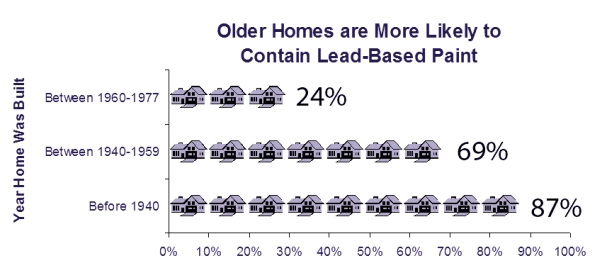
When does lead paint to become a concern?
Ok let's agree most adults are not chewing on lead-painted surfaces, but children will because lead has a sweet taste. Additionally, lead is but one of many coats of paint on a given surface. Each cost of paint makes the surface larger. The more coats of paint a surface contains the more likely that the surface bonds of the different layers can fail, and the paint can become damaged, which will liberate the lead paint. Additionally, who has not had a door or window stick? As surfaces receive more and more layers of paint the surfaces enlarge and friction surfaces such as doors or windows are larger and friction surfaces occur and paint rubs liberating lead dust.
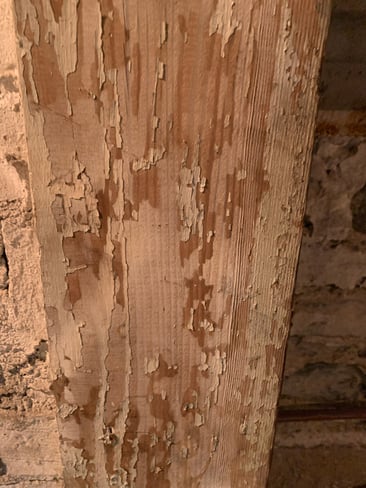
Nothing gets better with age and as lead paint ages, the paint starts to decay, fragmenting into flakes and dust that contaminate both the indoor and outdoor environment. Paint flakes and lead-contaminated dust are readily swallowed by young children who typically play on the ground and frequently put their hands to their mouths. Some children pick flakes of paint off surfaces and eat them.
Now lead is heavy and will drop to the ground, so kids touching the ground will have a high tendency to encounter lead dust.
What are the health impacts of lead exposure?
No scientific study has found the health benefits of lead to humans. Lead has no biological function in the body. Lead in fact will accumulate in the body, moving from the bloodstream to organs. Lead exposure can affect both adults and children, although it is particularly harmful to young children. This is because children have an immature developing nervous system which is vulnerable to the toxic effects of lead. Lead exposure in early childhood can result in reduced performance in school, reduced intelligence quotient (IQ), development of attention deficit disorder (ADD), and increased chances of developing behavioral issues. Lead exposure can also cause hypertension, renal impairment, immunotoxicity, and toxicity to the reproductive organs.
Not to be left out of the group susceptible to lead, pregnant women are also vulnerable. Lead exposure is associated with reduced fetal growth, lower birth weight, preterm birth, and spontaneous abortion. In short pregnant women will transfer the lead they ingest to their unborn children.
Do people with lead poisoning have symptoms?
Children with lead poisoning often have no symptoms. The only way to tell is to have your child tested. A child can be poisoned and show no outward signs. When there are symptoms, they can include diarrhea, stomach cramps, lethargy, vomiting, or seizures in some severe cases.
Why is there a lead limit of 90 ppm in paint instead of requiring paint to be lead-free?
Although it is generally accepted that there are no safe levels of lead exposure, complete removal of lead from paint is not 100% feasible. Paint manufacturers use ingredients that can contain lead contaminants, making completely lead-free paint infeasible. The 90 ppm limit was set so a low threshold could be established.
Free Consultation
888-301-1050
So is lead paint no longer made?
Lead paint is still manufactured, remember lead paint was banned in the United States by the Consumer Product Safety Commission. “Industrial” paints often contain high concentrations of lead and are often applied to exterior metal and concrete surfaces such as bridges, water tanks, and roadways.
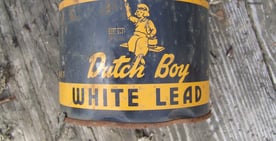
What should we do about paint that has already been applied in homes?
Clearly, the older the home the greater the chance lead paint is present, and the amount of potential lead is more significant when compared to newer homes. Again, in the United States lead paint was banned for consumer use in 1978, some states banned lead paint earlier than 1978 including New York and New Jersey.
Generally speaking paint in good condition, meaning not deteriorated does not pose a hazard. Remember any hazard relates to the Exposure Pathway of that hazard. If lead paint has not deteriorated, the lead in the paint, which by most all measures is under multiple layers of no lead-containing paint would not create an exposure pathway to humans. That said, television is filled with renovation programs. The small rooms in homes of the past are being replaced with great rooms (larger rooms that are joined into one room). So almost any renovation activity can create an exposure pathway for lead paint to be encountered by humans.
Fact: Any renovation, repair, or painting (RRP) project in a pre-1978 home or building can easily create dangerous lead dust.
There are regulations established by the Environmental Protection Agency (EPA) to manage lead paint. EPA requires that RRP projects that disturb lead-based paint in homes, childcare facilities, and preschools built before 1978 be performed by lead-safe certified contractors. Generally, EPA’s Lead RRP rule does not apply to homeowners doing RRP projects in their own homes. However, it does apply if you rent all or part of your home, operate a child care center in your home or if you buy, renovate, and sell homes for profit (i.e., a house flipper).
Activities such as renovation that can disturb legacy paint can result in harmful exposure to lead. Older homes have higher concentrations of lead in dust than newer homes.
Some governments have programs to address legacy paint. For example, information on addressing legacy lead paint in the United States is available at the EPA.
There are two proven methods of testing surfaces for lead paint. First is to scrape the paint off a give surface and have the paint laboratory analyzed. EPA sets standards and licensing for laboratories to perform testing of material and lead is no exception.
There are also licensed companies and inspectors that can onsite test surfaces for lead using specialized equipment. Portable x-ray fluorescence (XRF) analyzers are the de facto standard for onsite testing (see ASTM F2853-10(2015).
You likely will come across at-home test kits that use a chemical reaction for lead in paint. The issue with these DIY kits is you may have so many coats of paint that you are not actually encountering the painted surface with lead.
I heard lead paint was found in homes built after 1978.

First any home built before 1978 can have lead. We have also found lead in houses built after 1978, but typically on the trim inside a home. This is because while a can of paint may not be sufficient to paint a room, a can could likely paint all trim in a room and maybe even a house. In short, since the trim is commonly white and many lead paints were white, we have found that older paint that contained lead was applied to trim in homes built after 1978.
There are also things called heirloom pieces, think old trim or an old mantle or built in cabinet that was salvaged or recycled from an older home (before 1878) and installed in a new home, boom lead paint.
I am a landlord, how do I know if my rental property has lead paint?
You can have a certified inspector perform a lead paint inspection, which is a surface-by-surface inspection for lead paint. The inspector is trained and uses a calibrated XRF unit to measure for lead on surfaces. Depending on the living space the inspector could test dozens or hundreds of surfaces for lead.
I live in an old apartment it likely has lead paint, what is the benefit to know where the lead paint is located?
Knowing you have a hazard and where the hazard is located can help you manage the hazard. Knowing that your stair risers have lead paint on them and knowing your kids scuff these surfaces you can take measures to prevent these surfaces from being scuffed. If your walls have lead paint and you are renovating, you want the lead paint managed in a lead-safe manner. Perhaps some windowsills have lead paint on them. Perhaps you want to replace the windows. You will want to manage the lead in a safe manner, you may also want the contractor to remove the lead surface. Again, if you know where the hazard is you can manage that hazard, knowledge is empowering.
We are renovating our home and the home is old. Our contractor has not discussed lead paint. Should I be concerned?
Yes, you have cause for concern, if your home was built before 1978 lead can be present. You need to bring the lead paint issue up to the contractor. Generally speaking, the safest approach is to assume lead paint is present and manage that risk accordingly. Now that is also a safe and expensive approach. You may want to hire a lead paint inspector to test areas that will be renovated for lead so you know 100%.
I am a contractor and will be working with lead paint, do I need to be certified?
Yes, you must become certified to work on properties that may contain lead paint. See the EPA's Small Entity Compliance GuideOpens In A New Window handbook on the Renovation, Repair and Painting Rule.
